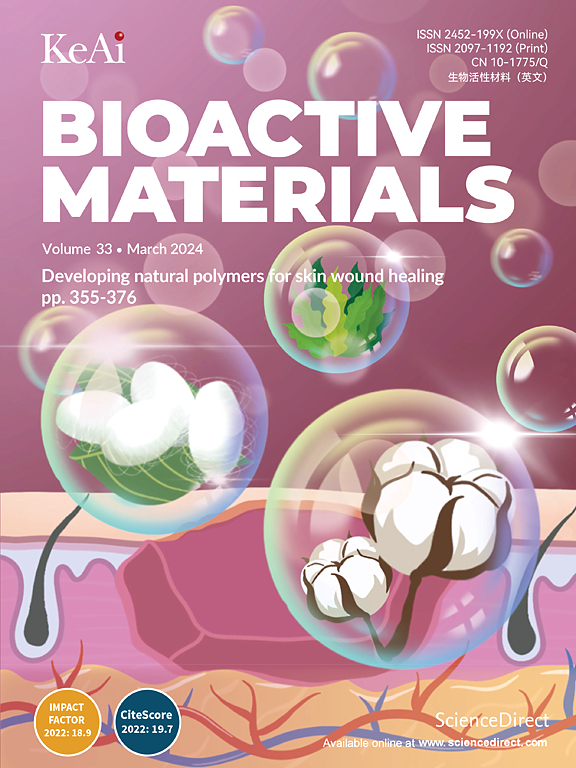Advancements in biomaterials and bioactive solutions for lumbar spine fusion cages: Current trends and future perspectives
IF 18
1区 医学
Q1 ENGINEERING, BIOMEDICAL
引用次数: 0
Abstract
Spinal fusion is considered today as the last treatment option for different spinal conditions, such as degenerative and infectious illnesses. It consists of fusing two or more vertebrae to obtain reinforcement/fixation based on several methods used to sustain osteosynthesis and grafting, such as cage insertion in the intervertebral space, which provides an important level of mechanical stability, impacting only a low amount of the natural biomechanics of the spine and facilitating the implant bony ingrowth. This review paper first explores the background of intervertebral fusion, emphasizing medical applications and material properties of interbody fusion cages. It then provides a brief historical overview and discusses antibacterial efficacy-related issues. Additionally, some of the most met-in-clinical practice lumbar interbody cages with a detailed description of their geometry and examples of clinical trials performed worldwide are provided. The biomaterials used in lumbar cage manufacture are comprehensively described. In the last part of this review paper, special attention is devoted to prospective biomaterials and coatings for spine fusion cages. Firstly, the rationale for using Mg-based alloys or high osteogenic polycaprolactone as biodegradable and bioresorbable alternatives in the spinal cage industry, addressing the clinical limitations of traditional Ti alloys and polyether ether ketone, is provided. Then, a more conservative approach, focusing on the use of bioactive or antibacterial coatings on the already certified biomaterials, is presented as a second alternative to the existing products on the market. Relevant literature studies are reviewed, and the osteointegrative, bioactive, or antibacterial character of the coatings is explained. Finally, our review identifies current clinical limitations and offers future perspectives that will provide better bioactive solutions, improving the existing biomaterials.

腰椎融合器生物材料和生物活性解决方案的进展:当前趋势和未来展望
如今,脊柱融合术被认为是治疗各种脊柱疾病(如退行性和传染性疾病)的最后一种选择。它包括融合两个或多个椎体以获得加固/固定,基于几种用于维持骨合成和植骨的方法,例如椎间隙内插入笼,它提供了重要的机械稳定性,仅影响少量的脊柱自然生物力学,并促进植入物骨长入。本文首先探讨了椎间融合的背景,重点介绍了椎间融合器的医学应用和材料特性。然后提供了一个简短的历史概述,并讨论了抗菌功效相关的问题。此外,本文还提供了一些临床实践中最常用的腰椎椎体间固定架,详细描述了其几何形状和在世界范围内进行的临床试验实例。在腰椎笼制造中使用的生物材料进行了全面的描述。在这篇综述的最后一部分,特别关注脊柱融合器的生物材料和涂层。首先,提供了在脊柱笼工业中使用镁基合金或高成骨性聚己内酯作为生物可降解和生物可吸收替代品的基本原理,解决了传统钛合金和聚醚醚酮的临床局限性。然后,一种更保守的方法,侧重于在已经认证的生物材料上使用生物活性或抗菌涂层,作为市场上现有产品的第二种替代方案。综述了相关文献研究,并对该涂层的骨整合、生物活性和抗菌特性进行了阐述。最后,我们的综述指出了目前的临床局限性,并提出了未来的观点,将提供更好的生物活性解决方案,改进现有的生物材料。
本文章由计算机程序翻译,如有差异,请以英文原文为准。
求助全文
约1分钟内获得全文
求助全文
来源期刊

Bioactive Materials
Biochemistry, Genetics and Molecular Biology-Biotechnology
CiteScore
28.00
自引率
6.30%
发文量
436
审稿时长
20 days
期刊介绍:
Bioactive Materials is a peer-reviewed research publication that focuses on advancements in bioactive materials. The journal accepts research papers, reviews, and rapid communications in the field of next-generation biomaterials that interact with cells, tissues, and organs in various living organisms.
The primary goal of Bioactive Materials is to promote the science and engineering of biomaterials that exhibit adaptiveness to the biological environment. These materials are specifically designed to stimulate or direct appropriate cell and tissue responses or regulate interactions with microorganisms.
The journal covers a wide range of bioactive materials, including those that are engineered or designed in terms of their physical form (e.g. particulate, fiber), topology (e.g. porosity, surface roughness), or dimensions (ranging from macro to nano-scales). Contributions are sought from the following categories of bioactive materials:
Bioactive metals and alloys
Bioactive inorganics: ceramics, glasses, and carbon-based materials
Bioactive polymers and gels
Bioactive materials derived from natural sources
Bioactive composites
These materials find applications in human and veterinary medicine, such as implants, tissue engineering scaffolds, cell/drug/gene carriers, as well as imaging and sensing devices.
 求助内容:
求助内容: 应助结果提醒方式:
应助结果提醒方式:


